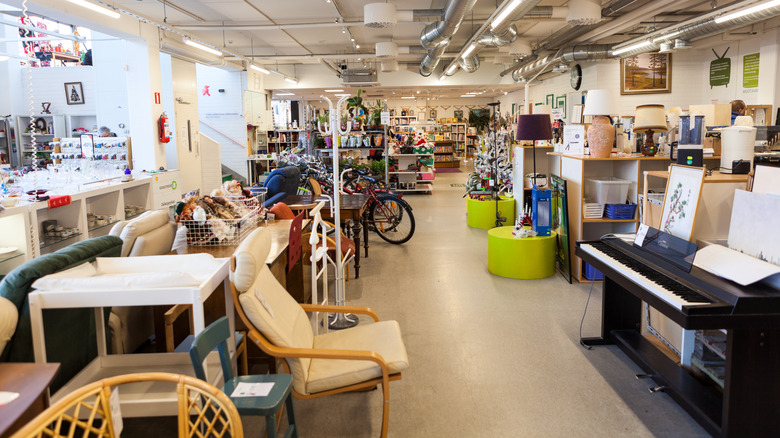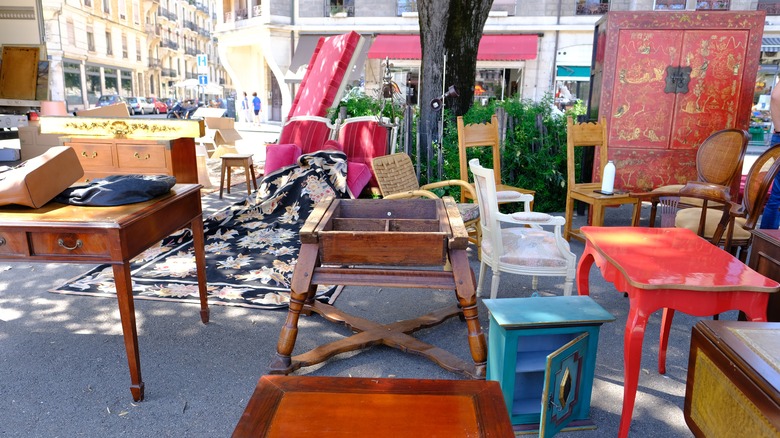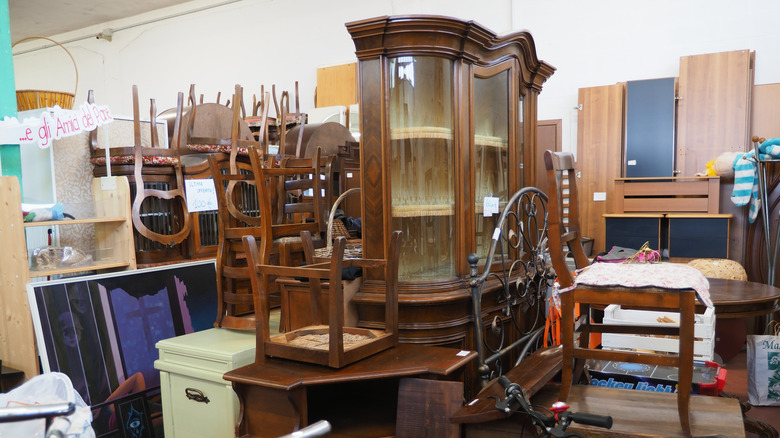5 Expert Tips For Thrifting Home Decor
You don't have to spend a lot of money to have a stylish home. In fact, even if you have the budget for all new furniture, buying used offers many benefits. Greener Ideal states that investing in pre-owned items is also better for the environment. The final destination for about 80% of furniture is a landfill, while the production of new items uses fossil fuels and contributes to deforestation. So, upcycling used home décor keeps useful products out of the garbage and prevents more from being made.
In addition to being better for the environment, you keep the money in your community when you thrift items locally: If you purchase from an individual, you are putting that money straight into their pockets instead of handing it to a large corporation. Thrift stores often support community causes like food banks or shelters as well, but regardless of where you shop, any time you buy used home décor within your community, you are supporting a good cause and saving money.
1. Look for online sellers
Facebook Marketplace has become a leader in product sales; while Craigslist used to be the go-to online option to buy locally, the social media platform's trade space offers an integrated approach to local buying and selling on a site you probably already use, states Business News Daily. Facebook Marketplace offers a search function, and you can select the radius in which you are willing to travel to find what you are shopping for.
However, like with all online shopping platforms, you have to be cautious of scammers. Reader's Digest suggests avoiding dealing with anyone who wants to communicate outside Facebook, like by phone or email. Transactions taking place outside of the platform are not guaranteed, and the company cannot take action against a scammer for sale outside of the marketplace.
Another online marketplace for home décor is eBay, which has been around for nearly three decades, according to Britannica. You can shop for large items like furniture in your area or smaller items from around the world that require shipping.
2. Go through church rummage sales
Church rummage sales are a great way to get a good deal on various products. Since churches collect items from their congregation, they usually have a lot of stuff, and also, because they are usually not emotionally attached to anything they're trying to sell, the prices tend to be exceptional.
Resalvaged recommends shopping early in the morning to access the best selection. Antique furniture, collectibles, and high-quality home décor are all items that will sell quickly. But, if it's a bargain you are seeking, go later in the day when the workers are tired and just need to get all the stuff out the door, so they don't have to pack it all up.
Church rummage sales happen year-round and are usually taking place inside, so winter thrifters can benefit from keeping an eye out for these events from January through December. Also, watch online marketplaces and store and library bulletin boards for upcoming rummage sales. And, be sure to tell your friends (if they frequent a church) so they can let you know if their church has a sale coming up soon.
3. Try thrift stores
Thrift stores have a little bit of everything and usually operate on a schedule similar to retail stores. So, unlike rummage sales, you can shop when you feel like it. Thrift stores are very popular for many reasons: Some people need to save money — like when your kid outgrows all of his jeans seemingly overnight — while others just like the thrill of the hunt. If you're the kind of person who is always looking for something unique or a new project, thrift stores are for you.
Haven House Thrift Store states that shopping for home décor in such a place offers you more creative opportunities. You can get a bargain on a rough or outdated piece of furniture, make a few changes to it or simply add a fresh coat of paint, and suddenly, you have a one-of-a-kind statement piece in your house.
To find the most interesting items at your local thrift store, visit frequently. If you are a hard-core bargain-hunter, keep an eye out for sales. To keep items from hanging around too long, many stores will put certain colored tags on sale each week or mark down a specific category. For example, one store might sell all wall art for 50% off on a certain day. Also, follow your favorite thrift stores on social media to get a heads-up about new arrivals and sales.
4. Yard sales for the win
According to PODS, you can find yard sales all year long in some places, but they are most popular in the spring and summer. Yard sales usually happen on the weekends since that's when most people are available to shop, and typically start around 7 a.m. to take advantage of the cooler weather, so arrive early to get the first crack at the good stuff.
One of the best things about yard sales is that you can haggle for the best price. See a piece of furniture you want but don't like the price? Ask if they will take less. The worst that can happen is they say no, but usually, sellers are motivated to get rid of all the stuff they have worked to haul out onto the lawn, and they do not want to risk having to take it back in. It can be a little uncomfortable to haggle at first, but it's easier if you carry small bills. If you see a table you like marked $100 but are offering $80, don't hand over a $100 bill and expect change. Instead, hand them the exact amount so everyone feels more comfortable about the transaction.
5. Estate auctions are worth it
Navigating an estate auction can be a little overwhelming, but it's worth learning how it works because you can get some truly amazing furniture and art pieces. To find out when and where these sales are happening in your area, Cupcakes and Cashmere suggests signing up for alerts at EstateSales. You can also simply do a Google search for auction houses in your area.
Once you have found a sale you want to attend, find out when you can arrive to check out the inventory, then make notes about what you want to bid on. To keep from overspending, consider setting a maximum amount you are willing to pay for each item so you don't get drawn into a bidding war.
For example, if you fall in love with an antique waterfall armoire, but you know you do not want to spend more than $2,000, it takes some willpower to stop bidding at that point; however, you do not want to get it home and regret spending $3,000 on it just because you wanted to win. Buyer's remorse can happen while thrifting, so sticks to your budget. There will be another deal at another time.





